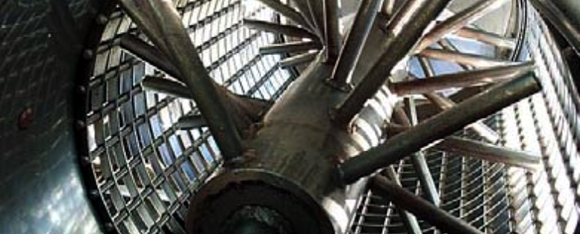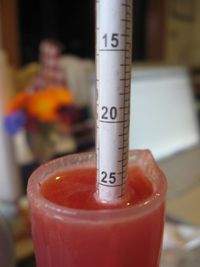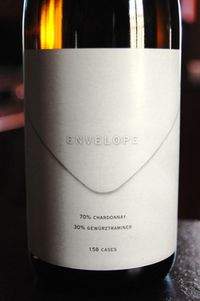
A destemmer awaiting clusters (Photo courtesy of Ramón Mira de Orduña Heidinger)
By Tom Mansell, Science Editor
Anyone with any involvement in wine knows that the world of wine has a unique vocabulary.
In a wine context, words like flabby, austere and even "mineral," take on meanings far from their dictionary definitions. Additionally, like in any trade, specific techniques for producing wine lead to specific names for such techniques.
While many people in the trade read this blog, I'm willing to bet that the majority are interested wine drinkers. In this edition of what I hope will become a recurring series, I'll explore and define some words and phrases that you might see from winemakers and growers that are bringing in grapes for harvest and preparing for fermentation.
 Brix: Many use "Brix" as a simple approximation for the percentage of fermentable sugars in the grape juice coming in from the vineyard. While this is pretty close, Brix is actually a measure of soluble solids in the liquid in grams solid per 100 grams of liquid at 25 degrees Celsius. Ninety to ninety-five percent of these soluble solids are in fact fermentable sugars like glucose and fructose. The remainder comprises non-fermentable sugars like xylose and arabinose, organic acids (malic and tartaric, mostly), and polyphenolic compounds. Measurements of Brix can be done with refractometers (convenient in the field, by refractive index), hydrometers (by density, at right), or by infrared detection. Other measurements of the same property include the German Oeschle, the French Baumé, and the brewers' Balling and Plato.
Brix: Many use "Brix" as a simple approximation for the percentage of fermentable sugars in the grape juice coming in from the vineyard. While this is pretty close, Brix is actually a measure of soluble solids in the liquid in grams solid per 100 grams of liquid at 25 degrees Celsius. Ninety to ninety-five percent of these soluble solids are in fact fermentable sugars like glucose and fructose. The remainder comprises non-fermentable sugars like xylose and arabinose, organic acids (malic and tartaric, mostly), and polyphenolic compounds. Measurements of Brix can be done with refractometers (convenient in the field, by refractive index), hydrometers (by density, at right), or by infrared detection. Other measurements of the same property include the German Oeschle, the French Baumé, and the brewers' Balling and Plato.
Cold Soak: After red grapes are brought in, many winemakers will put them into cold maceration. The grapes soak for on the order of days, often with dry ice or liquid nitrogen. Cold soak has been shown to increase anthocyanin (i.e., color) and tannin extraction in reds. Other benefits include decreased oxidation due to enzymes like laccases, which can build up due to Botrytis infection. Finally, the direct application of cryogens like dry ice can shatter the cell structure of some grapes, releasing helpful enzymes that can contribute to flavor development down the road (Zinnai, A.; Venturi, F.; Andrich, G., "Cold maceration in production of high quality wine," First international Symposium on Environment Identities and Mediterranean Area, 2006)
Crush: Pretty self-explanatory. Grapes are mechanically
beaten up, breaking the skins and releasing juice. Along with juice,
crush releases esterases and pectinases from the berries that set about
helping to clarify the must and ease the pressing process. During
crush, it's important to consider the fate of seeds and stems, since
breaking them could release bitter flavors and green aromas, again,
depending on their ripeness.
Destem: Pretty self explanatory as well. After harvest, clusters can be sent through a machine that removes the rachis (stem) of the cluster without damaging grapes. This is especially important for red wines, since fermentation occurs on skins. Sometimes, though, destemmers can leave jacks (individual stems) on the berries, so hand-destemming, while labor intensive, is not uncommon. Under some circumstances, stems can impart off-flavors to wines, including methoxypyrazines (green bell pepper, asparagus) and bitter ("green") tannins. Some winemakers, though, (notably locally, Tom Higgins of Heart and Hands Wine Company) claim that some stems in the fermentation can add complexity to the wine.
Free Run: Juice (whites) or wine (reds) that flows out of the
press before pressing has begun. It's generally looked upon as the
best juice, since it's the most gently handled. Free run will usually
go into top-of-the-line labels and varietal wines.
Press Fraction: The complement to free run. Presses can reach
pressures of up to 3 atmospheres near the end. To give you an idea of
what that's like, it's the approximate equivalent of a weight of 200
pounds placed on the area of a soda can. Attempts to use high pressure
to extract every last ounce of juice from the grapes, though, don't
really pay off. The last (hardest) press fraction will often have
higher pH (due to extraction of potassium ions from skins), higher
phenolics (due to broken seeds, stems, etc.), and, generally, taste
like crap. Interestingly, later press fractions turn out much clearer,
since the buildup of skins and seeds (aka pomace) acts as a sort of
filter. Slightly less hard press (and much more drinkable) fractions
will often end up in second labels or house blends.
 Skin Contact: Essential for reds, controlled in rosés, usually
Skin Contact: Essential for reds, controlled in rosés, usually
minimal in whites, with notable exceptions. Anthocyanins and tannins,
which bring color and structure to reds, are found in the skins, but
bitter and undesirable phenolics can be found there as well, especially
in not-so-ripe vintages. Again, judicious use of skin contact can be
good for some white wines. Atwater Estate Vineyards on Seneca Lake uses a bit of skin contact (usually cold soak) to add some complexity to its Gewürztraminer, and Channing Daughters
on the South Fork of Long Island ferments a few of its whites on the
skins, leading to extremely interesting and unique wines like Envelope, Meditazione
and the newly released Ramato.
Whole-cluster press: Just what it sounds like. Whole clusters, stems and all, are placed into the press. Stems actually allow for better extraction of juice with lower pressure, which for whites leads to less extraction of bitter phenolics from the skins. Whole cluster press is a way to obtain absolutely minimal skin contact, so in a year where skins are not as ripe as usual, it's preferable. Generally, its usage varies by year, grape, ripeness, etc.
This is just a snapshot of the many, many decisions available to the winemaker, and fermentation hasn't even started yet!
